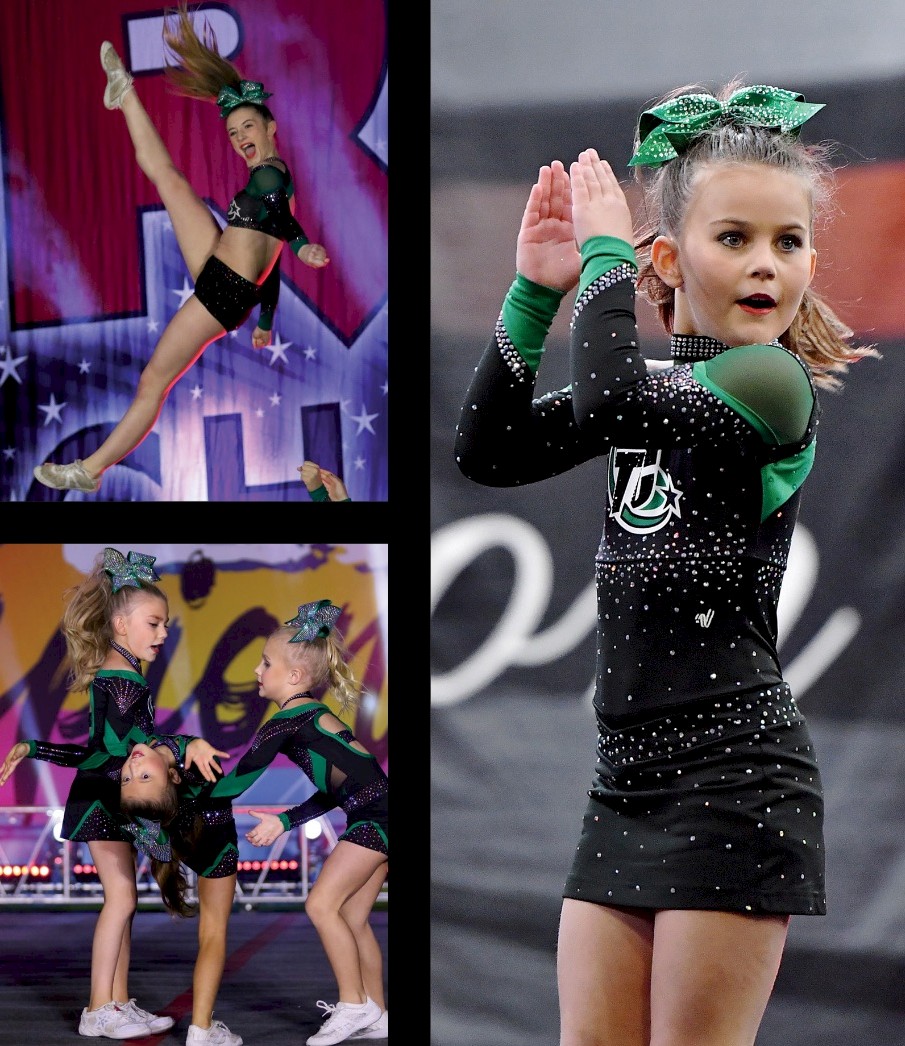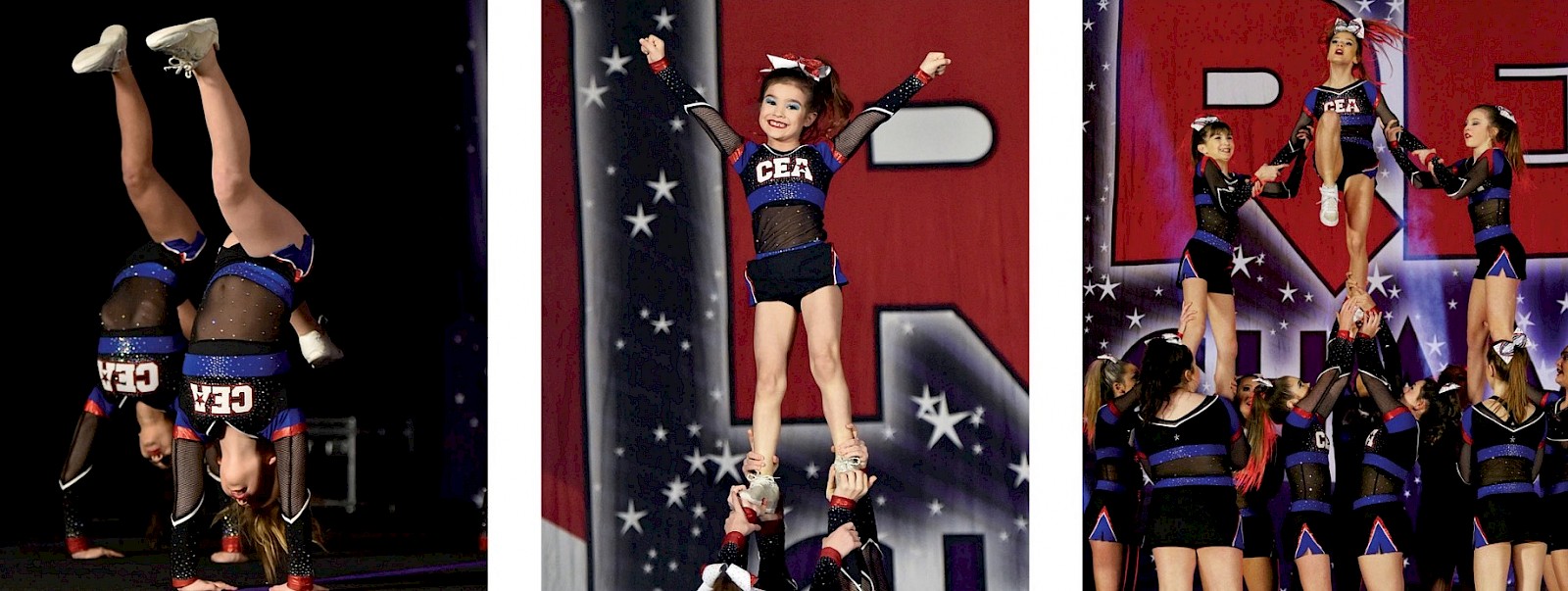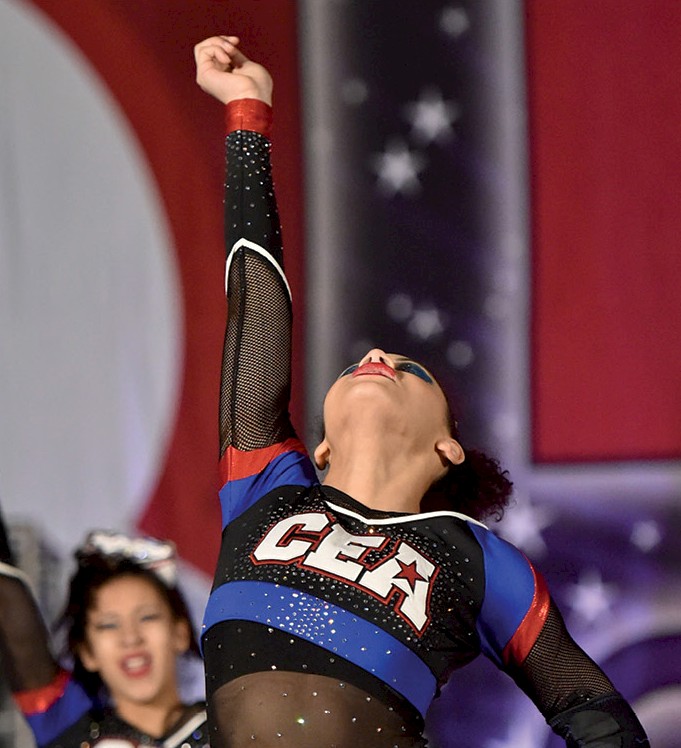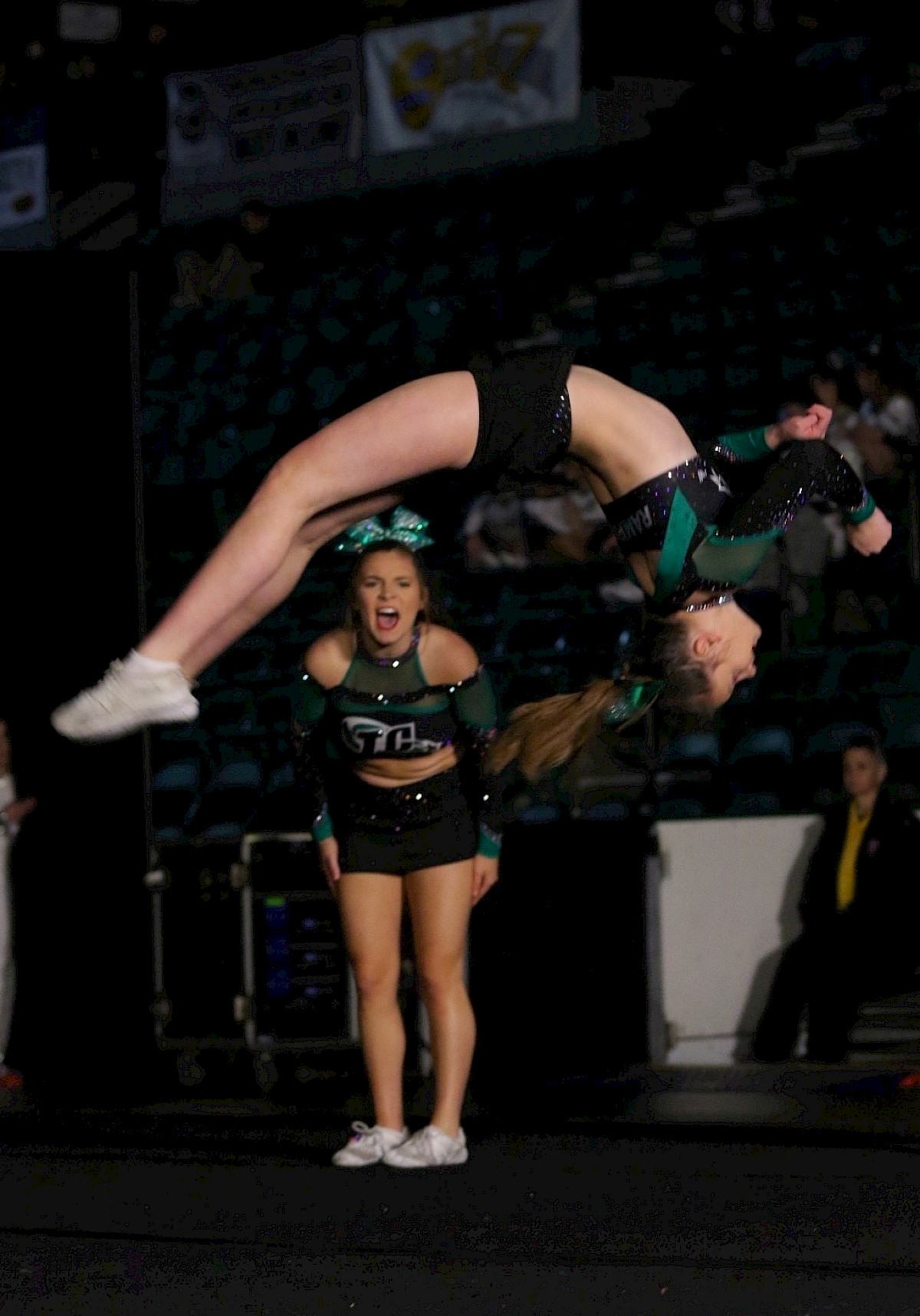Ready? OK!
Dedication, athleticism, and poise...
Three words that come to mind when I think about cheerleading. The question is often asked, “Is cheerleading a sport?” If you have ever asked a cheerleader, you have no doubt gotten an earful. As a former cheerleader, former cheer coach and a current cheer mom, I have plenty to say and was really excited when Texarkana Monthly asked me to be a guest writer.
Did you know that cheerleading actually dates back to the late 1800s, and it was originally an all-male sport? According to an article by Pacific Standard Magazine, “The Manly Origins of Cheerleading” by Lisa Wade, early cheer was “characterized by gymnastics, stunts, and crowd leadership, cheerleading was considered equivalent in prestige to an American flagship of masculinity football.” The article outlines how cheer transitioned from a male to female-dominated sport. After reading this article, I did a little more digging and learned a lot about cheer that even I didn’t know. In 1884, Princeton University came up with a cheer for the crowd to boost spirit. At a game against the University of Minnesota on November 2, 1898, student Johnny Campbell noted the concept and organized Minnesota fans in chanting for their team. As a result, he is often given credit as the first official “cheerleader” (EpicSports.com) and this date is given as the official birth date of organized cheerleading.
In the late 1920s, the University of Minnesota allowed women to participate in cheer even though most schools still did not. However, it wasn’t until World War II, as men headed off to war, that we see women really stepping onto the sidelines. As women moved in, parts of society deemed cheerleading “too masculine” and an evolution began. Because pants were not part of the acceptable everyday clothing of women of the teens and twenties, I feel quite certain the ankle-length skirts they sported played a role in this early evolution. By the 1950s, cheerleading was a female-dominated sport, and that trend continued well into the 70s. By 1975, 95% of cheerleaders were female (Hanson, Mary Ellen. Go! Fight! Win!: Cheerleading in American Culture)
While high schools across the nation boasted squads of beautiful, bubbly females, the collegiate level was still home to a fair share of male cheerleaders. One cheerleader in particular, Lawrence Herkimer, was already making waves and would eventually revolutionize the sport. In 1949, Herkimer, a former cheerleader from Southern Methodist University, administered a cheerleading education clinic. The first clinic had only 52 participants; the second had 350! He founded the National Cheerleading Association (NCA), and by the 1960s, college cheerleaders could find employment with NCA by coaching workshops around the country. The popularity of NCA and the ability to teach cheerleaders proper technique led to the invention of new jumps, stunts, uniform styles and ultimately competitions. NCA is still considered paramount in cheerleading. To win NCA nationals, or work on the NCA staff, is often a cheerleader’s ultimate goal. Texarkana native and current University of Central Arkansas cheerleader, Haley Smith, is part of the NCA staff. “Because cheer has had such a big influence in my life, I’m very passionate about it. I love that being part of the NCA staff allows me to spread my love for cheer to younger people,” she said.

The 1980s introduced difficult stunts and gymnastics to cheerleading on a whole new level. In 1983, ESPN aired the first televised cheerleading competition. The 80s also brought the birth of all-star teams, squads that work solely towards the goal of competing. Concepts expanded, and teams at every level became more and more focused on athleticism. Tryouts were judged by knowledgeable outsiders, and spots were earned on merit. The tryout process and the general nature of cheer, instills a sense of confidence and creates growth in its very own way. Joni Wright, owner of Joni’s Gymnastics, Dance and Cheer Centre, home of Cheer Elite All-Stars, elaborated, noting that cheerleading has a tremendous impact on the lives of cheerleaders outside of the gym. “One of the most important things cheerleading instills is confidence. This is because it shows you that you can accomplish difficult things and it surrounds you with good, supportive friends, and among other things teaches the athletes to stand up for themselves, enthusiasm, focus and determination, teamwork, to be fearless, to deal with high-pressure situations, commitment, setting goals and to never stop smiling.”
So, what really defines a sport, anyway? According to Bing.com, a sport is “an activity involving physical exertion and skill in which an individual or team competes against another or others for entertainment.” When I asked local Twin City Cheer and Gymnastics owner, and Pleasant Grove cheer coach, Shera Hopkins what she thought, she exclaimed, “Of course I consider it a sport. I think the physical, emotional part, the hours of training, and even the injuries are consistent with all types of sports. Plus, the dedication these kids put into trying to better themselves and improve their skills is equal to athletes in all fields.” Joni got straight to the point saying, “They get judged, they compete, they have to stay conditioned; what could possibly make it not a sport?” I couldn’t agree more! Cheerleading involves physical exertion, skill, and competition. Can you hold an entire person in the air over your head? What if I asked you to yell and dance while holding them?
Former University of Arkansas cheerleader Cheyenne Jester really hit the nail on the head when she said, “I think the hardest part about being a cheerleader is the lack of credit we get. Some people think we just stand on the sidelines to look pretty. What they don’t understand is the time and effort we put in. They don’t understand the pressure we put our bodies through—the wear and tear of cheerleading. They do not understand that it takes coordination, technique, strength, and a lot of practice to cheer and execute skills. Not only are we there to support other teams, but we are also focusing on our technique, execution of routines, while also paying attention to the sport we are cheering for to make sure we are cheering the correct cheers at the right time. Routines are to be memorized on top of motions, (and) skills, all the while being a part of another game!” Shera’s answer reiterated this sentiment as well. “There are so many skills and qualities that they have to have, not just jumps and tumbling. They have to be well-rounded and do every part of the routine.”
Coaches and athletes alike talked about the hours they spend practicing and working to hone their skills. Haley said that she often meets up with her collegiate teammates for additional practices, especially stunts and tumbling, and that many on her team continue to perfect their technique working with private coaches. A competitive cheerleader will also spend time in both cheer and tumbling classes. Shera commented that she strives for her athletes to, “find a balance between working hard, but not being overworked, so they still have time to be involved in their school.” She also pointed out that, “commitment plays a role and if they aren’t committed to a full year, it impacts the team; teaching the life lesson that if you start something, you finish it.” Both coaches stressed the importance of teamwork. Joni said, “The athlete must take their placement on the team seriously. This is not a sport with an ‘I’ in teamwork! They must always work together to accomplish their goals and hit their routines correctly.”

One key example of the role of teamwork in cheerleading is stunting. In order to stunt properly, a cheerleader must have a strong core, legs, and arms. It involves a mix of partner stunts comprising a flyer (the person in the air) and a base (the person holding them up) and group stunts, where multiple people serve as the base. Part of what makes stunts so spectacular is the ability of cheerleaders to build their strength and hone technique to simultaneously perform skills. Often, you see multiple stunt groups connected in the air by their flyers, or a flyer that changes groups in mid-air. Stunts like these are called pyramids. Pyramids are both amazing and dangerous. If the timing is off in the group, the chance of the stunt collapsing increases significantly. According to the National Center for Catastrophic Sports Injuries, “female cheerleaders make up 50% of the catastrophic head, neck and spine injuries suffered, specifically by female athletes.” The NCCSIR conducted a 31 year study on all sports from 1982 to 2013 and found that in terms of catastrophic injury to female athletes, 64.2% of high school and 71.2% of collegiate level injuries were cheer related. FactRetriever.com even places cheerleading as the second most dangerous sport with football as number one, and the cheerleader at the top of the pyramid is ten times more likely to get a concussion than a football player.
Like in other high-risk sports, cheerleaders enjoy pushing themselves to work hard and accomplish difficult tasks. Haley said, “Honestly, it’s taught me a lot about myself. It keeps me going, keeps me in shape, and just focused on life in general. After I tore my second ACL, it’s what pushed me to get better, through therapy and stuff because that was really hard for me, but I knew that I had to keep working to get back to cheer.”
For local cheer mom Jamey Tice, her girls were active and high energy, so she really “wanted to give them something constructive to work towards.” Her girls love going to the gym. Her 12-year-old daughter, Jacey, said, “To be a good cheerleader, you have to be able to focus and always have a good attitude.” Jacey also said that some of her closest friends are from her cheer team, and that makes cheerleading a lot of fun. She added, “We spend a lot of time together and get to know each other’s likes and personalities, and we all cheer in different ways.” When I asked little sister Jessa Tice what she would say to someone interested in cheerleading, she said that she would tell them, “Don’t be fearful. You can work hard and you can do it.” That might be one of the coolest things about cheerleading. Even though it is a lot of work and highly competitive, like Jessa, these athletes tend to be natural encouragers.
Another key aspect of cheering involves jumps and tumbling. If you’ve never tried a toe-touch, one of the most quintessential cheer jumps, I encourage you to give it a shot. (Stretch really well first, though, I would hate for you to pull a muscle!) Cheerleaders dedicate a lot of time to jump and tumbling practices. This time includes stretching, strength training, and typically private coaching in order to understand and perfect technique. Tumbling passes frequently seen include everything from a back handspring to a full. A full is a tumbling pass where you make a full rotation of the body in the air while also flipping over backward. Hard to explain, even harder to do, but amazing to watch! When asked, both of the Tice girls said that tumbling was their favorite skill to work on. Jessa at just nine recently learned how to do a round-off back handspring back tuck. Jacey has perfected her aeriel and can incorporate it into other complicated tumbling passes.

Dance and yelling (cheering) are also integral parts of cheerleading. Dance requires core strength, stamina, and flexibility. Both of the coaches I spoke to said that a large portion of practice is dedicated to simply running the routine over and over to increase stamina. They will run the routine and focus on a singular aspect, such as motions, and once that is “clean,” run the routine and focus on something different, like stunting, until the athletes are able to run the entire routine with no flaws. The parts of perfecting a routine are knowing the skills, understanding how to count music, and being able to maintain your timing within the group. As for the actual cheering aspect, try yelling throughout your entire next workout and let me know how that goes.
Finally, one of the most important aspects of cheer is trust. I feel certain there is a level of trust needed for almost all team sports, but I do not know that it can exceed the level of trust required in cheer. If you’re going to allow people to pick you up and throw you in the air, you have to trust they are going to catch you when you come back down. As a base, you must trust the flyer knows the timing of the routine and will come down in the correct position for catching and no matter what, the other bases will do their best to help you catch even when the dismount does not go as planned. A cohesive team means abounding trust, and as a result a high-level of bonding occurs. In my time as a cheerleader and even as I’ve watched the girls I have coached grow, I see so many of their friendships continuing, like many of my own friendships formed from my time as a cheerleader. When interviewing Cheyenne, she said, “My former teammates are most definitely an integral part of my life. I have built lifelong friendships with the girls I cheered with. Morning workouts, game days, events, practices—we lived and breathed cheer, and we did it by each other’s sides for many years! I have actually been friends with two of my cheer friends, Hailey Harris and Kaitlyn Kinder for 15 years. We have been through it all: competitive cheer, middle school, and high school cheer and stayed friends throughout college and we’re still going strong. They will even be my bridesmaids! I have 13 bridesmaids, eight of which were my teammates either in middle school, high school, or college, and it all started with cheer!”
What do you think? Is cheerleading a sport? If you’re holding onto the idea that it can’t be a sport if it isn’t in the Olympics, consider the fact that neither is football, mixed martial arts, or cricket. Softball and baseball were only added in 2020. The next time you find yourself at an event where cheerleaders are performing, give them an extra minute of your attention. Appreciate the time, dedication, and skill it takes. Yell along with them when they lead a chant. These athletes put themselves in harm’s way for your entertainment; take the time to admire their dedication, skill, and athleticism. ![]()


